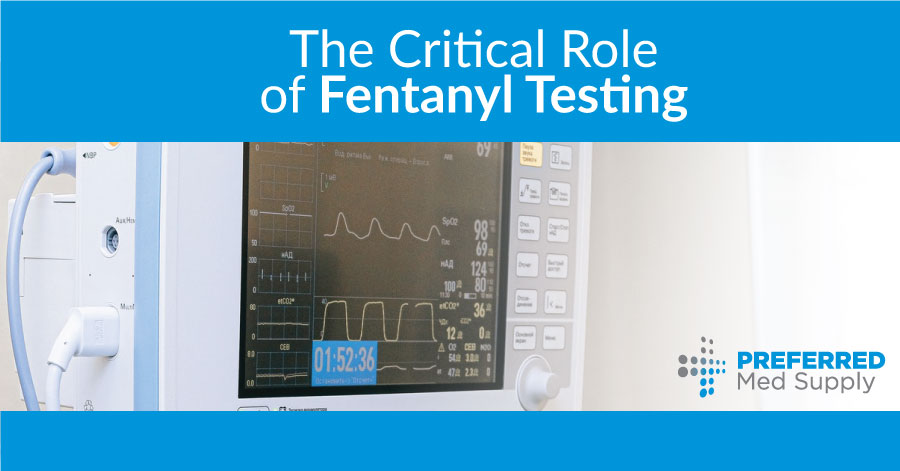In 2016 the U.S. saw a marked increase in drug overdose deaths. The total exceeded 64,000 overdose-related deaths. Largely contributing to the factors of the increase was the sixfold increase in deaths linked to the illicitly manufactured drug fentanyl. This drug has gained notoriety as being 50 to 100 times more powerful than morphine. In 2017 59% of opioid-related deaths involved fentanyl compared to only 14.3% in 2010. The rising popularity of fentanyl mixed with illicit drugs and the extremely high risk for a ‘bad batch’ has created a severe need for fentanyl identification, both in the user’s system or in a drug, for harm reduction.
Understanding Fentanyl
A powerful synthetic opioid, Fentanyl can be found as a prescription drug or as an illicit one, often mixed in with drugs such as heroin. As an opioid, it’s prescribed to patients with severe pain, usually in recovery from surgery or in hospice care. Some patients who endure chronic pain may also use it in small doses. Because of the strength and price of the drug, it can be a desirable compound to use in making a batch. But due to its strength, the margin for error is very slight. It is possible to develop a tolerance to fentanyl, but a brush with a bad batch can easily be lethal.
The production method of illicit fentanyl, much like any illicit compound creation is not an exact science. An amount as small as two milligrams can be lethal, depending on the person’s size and existing tolerance. For comparison, the equivalence of several grains of salt can cause of overdose. The DEA reports finding counterfeit pills ranging from .02 to 5.1 milligrams (more than twice the lethal dose) per tablet.
How Fentanyl Can Be Tested
Fentanyl can be tested through two main methods: a body sample, such as urine for fentanyl enzymes, or an ‘FTS’ or Rapid Fentanyl Test Strip. The first is a method of detecting that fentanyl has been used in a specific period of time and that there is an existing tolerance or addiction. The latter is used on a batch of drugs to check for the presence of fentanyl. This is normally part of a ‘harm reduction program.
Testing a Patient for Fentanyl in a Drug Panel
When testing for fentanyl in a patient, the most common method is to use a ‘dip card’, or ‘panel’ cup. These devices collected the sample and render an instant result (in several minutes) whether a chemical is present. This testing is unable to determine how much fentanyl was taken or when, but rather that it is present. This testing is immunoassay-based, if the presence of it is above a specified amount, it will turn a colored line on the test to indicate its presence. There is no ‘amount’ reported in the testing. While instant drug tests are common, many employers and testing sites perform a ‘collection’, then LC-MS (Liquid Chromatography-Mass Spectrometry) test on the same, rather than the rapid results. This is considered much more accurate but requires a chain of custody for the sample and a delay in reporting results. Samples collected in rapid result cups can also be tested in an LC-MS for further confirmation.
Fentanyl, while a dangerous and trending drug, has not historically been one that is included in a typical drug panel among the norms of cocaine, marijuana, heroin, and methamphetamines. While opioids typically are, fentanyl can be tested independently due to its unique composition. Because of this, fentanyl testing in urine is typically done with an individual dipstick that is done in addition to a testing cup. These test strips function identically to the ones ‘built-in’ to the cup, with the exception of the need for the manual manipulation.
Testing an Illicit Drug for Fentanyl
Rapid Fentanyl Test Strips (FTS) is a harm reduction intervention intended to reduce the incidence of overdose due to fentanyl. The presence of fentanyl is often unknown in drugs and can result in fatal outcomes. Similar to ‘Supervised Injection Facilities (SIF), this measure attempts to provide the opportunity for safer drug use rather than abstinence of drug use. FTS programs can be utilized in two ways, through residue testing, that is, testing of the illicit substance for the presence of fentanyl, or through urine testing as stated previously. SIFs are not legalized in the United States, but FTSs have been tested in areas including New England, North Carolina, and Canada. From studies into the effectiveness of these programs, some key takeaways were the following:
- Users held perceptions that most drugs were Fentanyl-contaminated
- More than half of the users who identified a Fentanyl-positive result altered their use due to the result.
- The majority of the participants in the study expressed positive opinions regarding the utility and simplicity of the test.
- The conundrum expressed by some participants is that: they are aware the danger of fentanyl, and yet, it is also indicative of a high they are seeking.
The cited study does not conclude with key takeaways but instead encourages further studies into the harm prevention by these initiatives.
Should I Test For Fentanyl?
Whether you are a user of substances and want to monitor whether there is fentanyl presence in the drug residue or you are on the enforcement side of a drug policy, testing for fentanyl is a metric for safety. The presence of fentanyl can be lifesaving and may also reveal an existing tolerance. For medical or treatment facilities, this is an additional key metric to be used in diagnostics. Fentanyl strips are an inexpensive addition to rapid drug panels and may well pave the way to preventing a tragedy.

